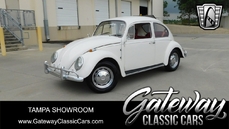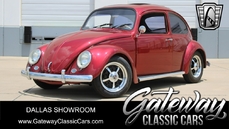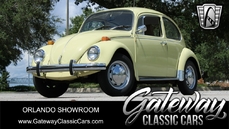Volkswagen Beetle Typ1 Sedan 1949
General description :
It could easily be argued that the Volkswagen Beetle (officially designated the Type 1) is the most popular and most recognizable car ever produced. Like the Ford Model T before it, the Volkswagen put a nation (and the world) on wheels thanks to its low cost and elegant mechanical simplicity. Despite its somewhat dubious roots within the Third Reich, the VW Beetle proved immensely popular in the post war years, particularly in a recovering Europe. In the US market, this funny little rear-engine car took some time to catch on, but once it did, it became immersed in popular culture, particularly through the 1960s. Many great mechanics and race car builders got their start tinkering with Beetles thanks to their simplicity, ease of service and surprising potential. A staggering 21.5 million examples were built between 1938 and 2003, becoming the longest running, highest selling, single-platform vehicle in history. From the first car to the last, changes were made not for the sake of change but always with the purpose of improvement and refinement.
1949 marked a major milestone for VW, as the year the very first Beetle was imported to the US market by the daring and brilliant Max Hoffman. Max Hoffman Imports had a bustling showroom in New York, and he was one of the most influential players in the European motoring industry, responsible for translating American tastes to European companies, along the way ensuring the success of companies like BMW, Alfa Romeo, Mercedes-Benz and Porsche established themselves in the fickle American marketplace.
While the Beetles of the 60s and 70s are most familiar to the general public, it is the cars built in the 1950s and earlier that attract the most attention from serious collectors and enthusiasts. They are considered the purest of form, and are also among the rarest given the lower production numbers and high attrition rate. True to the original design by Dr. Porsche, the shape is subtle yet complex, with form following function in a classic Teutonic manner. The earliest years of Volkswagen production were limited, with production truly gearing up after WWII was over and Germany was in recovery.
This 1949 Volkswagen Type 1 is a beautifully and recently restored example finished true to original specification. The body is outstanding, with lovely Pearl Grey paint laid down over excellent panels. Decklids fit beautifully and the doors shut solidly with excellent gaps. It has a wonderful, simple charm to it, and the paint work is expertly finished, carefully executed to not appear too glossy but with a period appropriate sheen that lends the car a factory-fresh appearance. The bumpers are excellent, as are lamp bezels on the correct Bosch lenses. Plain, painted steel wheels wear blackwall tires and simple chrome hub caps emblazoned with the VW logo. Semaphores in the B-pillars harken back to the car’s prewar roots and the distinct lack of trim and brightwork recalls the VW’s singular purpose as the car of the people.
Charming simplicity continues inside where the accommodations are about as basic as you can get, however the impeccable quality of the restoration shines through in expertly fit fabric seat upholstery and fine quality detailing front and rear. Kick panels and sills are covered in German squareweave carpet and the floors lined in fluted rubber mat. The dash is about as uncomplicated as you can get, housing a speedometer, glovebox and little else. What switchgear there is (for headlamps, wipers and turn signals) is correct. The cabin is the perfect antithesis to today’s needlessly complex automobiles that are full of distractions; this is a tool for driving, something you use to get from point to point as efficiently as possible, and yet the VW accomplishes its purpose in such an endearing way.
A correct 1131 cc horizontally opposed four cylinder sits out behind the rear axle line. The engine number (1-0135937) corresponds with both the chassis and serial numbers on the data tag and stampings in the body. The engine is carefully and properly detailed with period appropriate parts such as the brown-top Bosch coil and distributor cap, and black lacquered ignition leads. Engine sheet metal is beautifully restored and painted in a semi-gloss black as correct. It is exceptionally clean and tidy, showing almost no use since the restoration.
This is a beautifully presented Beetle; a highly desirable example from the early days of this iconic machine and a pure, simple joy to drive. This example’s fresh and immaculately prepared restoration make it immediately ready for show and enjoyment.
https://hymanltd.com/vehicles/5872-1949-volkswagen-beetle-sedan/
1949 Volkswagen Beetle Typ1 Sedan is listed sold on ClassicDigest in St. Louis by Mark Hyman for $69500.
Car Facts
Car type : Car Make : Volkswagen Model : Beetle Typ1 Model Version : Sedan Engine size : 0.0 Model Year : 1949 Sub type : Sedan Location : Missouri
Sold
Seller Information
Sold
People who viewed this Volkswagen Beetle Typ1 also viewed similar Volkswagen listed at ClassicDigest
Other cars listed for sale by this dealer
About Volkswagen
The Volkswagen story is indeed an intriguing tale of innovation, resilience, and post-war revival, marked by various models that have become iconic in automotive history.The People's Car (Volkswagen): Initially envisioned by Adolf Hitler in the 1930s as a "people's car" or "Volkswagen" in German, the idea was to create an affordable and practical vehicle for the German people. This concept led to the development of the Volkswagen Beetle (or the Type 1), designed by Ferdinand Porsche.
Post-War Challenges: After World War II, Volkswagen faced significant challenges. The factory was heavily damaged, and the brand's association with the Nazi regime led to a lack of interest in the car in some regions.
British Intervention - The British Army & Ivan Hirst: The British Army took control of the factory in the immediate post-war period. Major Ivan Hirst, a British Army officer, played a crucial role in reviving Volkswagen. He recognized the potential of the Beetle and advocated for its production, convincing the British military to order several thousand cars. This decision helped jumpstart the brand's revival.
Export Success and the Beetle's Global Appeal: The Beetle gained popularity not only in Germany but also globally, becoming an icon of affordable motoring. Its simple, reliable design and unique appearance made it a favorite among consumers worldwide.
Model Evolution: Over the years, Volkswagen introduced various models alongside the Beetle, each contributing to the brand's growth:
Type 2 (VW Bus or Transporter): Introduced in the 1950s, it became an iconic symbol of the hippie movement in the 1960s, loved for its spaciousness and versatility.
Golf (Rabbit in the U.S.): Launched in the mid-1970s, the Golf (or Rabbit in the U.S.) marked a shift towards front-wheel-drive, modern design, and hatchback practicality, becoming a cornerstone of the brand's success.
Passat, Jetta, and Other Models: Volkswagen expanded its lineup with models like the Passat and Jetta, catering to different market segments.
Challenges and Innovations: Despite success, Volkswagen faced challenges, including quality issues in the 1970s. However, the brand continued to innovate and develop new models and technologies.
Rise of the GTI and Global Expansion: The 1980s saw the rise of the iconic Golf GTI, a high-performance version that sparked the hot hatch trend. Volkswagen also expanded its global presence during this period.
The British intervention in reviving Volkswagen after World War II played a pivotal role in the brand's resurgence. While there might have been some tensions or competition among automotive companies in the 1950s and 1960s due to Volkswagen's post-war success, the brand's ability to produce innovative and popular models solidified its place in automotive history.











